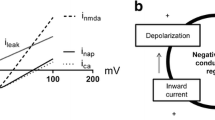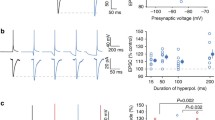Summary
Technical limitations with intracellular electrophysiological methods usually restrict recording of postsynaptic potentials only from neuronal soma, a site remote from the actual synapse. The intervening dendritic cable interposed between the actual synapse and the site of recording can significantly filter the synaptic signal. Therefore, investigations of drug effect on synaptic mechanisms, based on postsynaptic recordings obtained at the soma, must be interpreted with care. The potential role of dendritic cable filtering in the atypical pentobarbital depression of a K+-dependent inhibitory synapse between the P to Nut cell in the posterior packet of the leech was investigated. The effective electrical geometry under the conditions of control and 0.5 mM PNB sufficient to completely abolish the postsynaptic potential were determined from analyses of the membrane charging curves assuming the lumped-soma-short-cable model. Under the control condition, the postsynaptic Nut cell exhibits dendritic dominance with rho = 2.52, normalized equivalent cable length l= 1.08, and a membrane time constant tauo=52 ms. With phenobarbital application, changes in the geometrical parameters consistent with a decrease in the specific membrane resistance Rm are observed. Simulation of the drug induced change in the electrical geometry demonstrates that the decrease in the post synaptic potential is largely due to the decrease in the soma input resistance and an increase in the cable filter contributes little to the observed depression of the postsynaptic potential. However, the combined effect of the decrease in the input resistance and the increase in the cable filtering of synaptic current is insufficient in explaining the observed total block of the synaptic potential by PNB. Therefore, in leech, PNB block of a K+-dependent inhibitory synapse is not an epiphenomenon due to altered cable filtering.
Similar content being viewed by others
References
Brown TH, Fricke RA, Perkel DH (1981) Passive electrical constants in three classes of hippocampal neurons. J Neurophysiol 46:81–827
Carnevale NT, Johnston D (1982) Electrophysiological characterization of remote chemical synapses. J Neurophysiol 47:606–621
Coggeshall RE, Fawcett DW (1964) The fine structure of the central nervous system of the leech, Hirudo medicinalis. J Neurophysiol 27:229–289
Durand D (1984) The somatic shunt cable model for neurons. Biophys J 46:645–653
Gerschenfeld HM (1973) Chemical transmission in invertebrate central nervous systems and neuromuscular junctions. Physiol Rev 53:1–119
Jack JJB, Redman SJ (1971) The propagation of transient potentials in some linear cable structures. J Physiol (Lond) 215:283–320
Johansen J, Kleinhaus AL (1985) A monosynaptic connection between the medial nociceptive and the Nut cell in leech ganglia. J Comp Physiol 156A:65–69
Kleinhaus AL (1982) Comparisons between barbiturates and TEA actions on identified leech neurons. In: Klee MR (eds) Physiology and pharmacology of epileptogenic phenomena Raven Press, pp 243–249
Kleinhaus AL, Brand S (1981) A potassium-dependent inhibitory synaptic connection in leech segmental ganglia. Comp Biochem Physiol 70A:37–44
Muller KJ, McMahan UJ (1976) The shapes of sensory and motor neurones and the distribution of their synapses in ganglia of the leech: a study using intracellular injection of horseradish peroxidase. Proc Roy Soc Lond 194B:481–499
Nichols JG, Baylor DA (1968) Specific modalities and receptive fields of sensory neurons in the CNS of the leech. J Neurophysiol 31:740–756
Prichard JW (1972) Effect of phenobarbital on a leech neuron. Neuropharmacology 11:585–590
Prichard JW, Ransom BR (1989) Phenobarbital: mechanisms of action. In: Levy R, Mattson R, Meldrum B, Penry JK, Dreifuss FE (eds) Antiepileptic drugs. Raven Press, pp 267–282
Rall W (1969) Time constants and electrotonic length of membrane cylinders and neurons. Biophys J 9:1483–1508
Rall W, Segev I (1985) Space-clamp problems when voltage clamping branched neurons with intracellular microelectrodes. In: Smith TG (eds) Voltage and patch clamping with microelectrodes. Am Physiol Soc Bethesda, pp 191–215
Sato M, Austin GM, Yai H (1967) Increase in permeability of the postsynaptic membrane to potassium produced by “Nembutal”. Nature 215:1506–1508
Segal M (1983) Rat hippocampal neurons in culture: Responses to electrical and chemical stimuli. J Neurophysiol 50:1249–1264
Yang J, Chapman KM (1982) Frequency domain analysis of electrotonic coupling between Retzius cell membrane in leech CNS. Biophys J 44:91–99
Yang J, Kleinhaus AL (1982) Localizatin of a K-dependent inhibitory synapse in leech CNS. Soc Neurosci Abstr 8:252
Author information
Authors and Affiliations
Rights and permissions
About this article
Cite this article
Yang, J., Que, J., Kleinhaus, A.L. et al. Barbiturate depression of a K+ dependent inhibitory synapse is independent of dendritic cable filtering. Exp Brain Res 90, 319–326 (1992). https://doi.org/10.1007/BF00227244
Received:
Accepted:
Issue Date:
DOI: https://doi.org/10.1007/BF00227244




